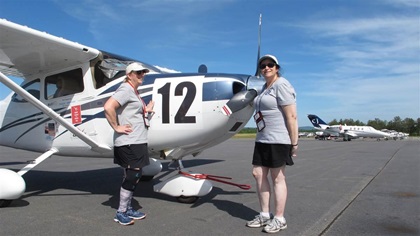Six women rose above to become Navy pilots
When the nuclear-powered aircraft carrier USS Abraham Lincoln sailed from San Diego on January 3 under the command of Capt. Amy Bauernschmidt, the first female officer to command a carrier, a notable item on the skipper’s résumé was her piloting experience including more than 3,000 hours in U.S. Navy aircraft and as commander of a helicopter maritime strike squadron.
Such accomplishments were unachievable—but never unimaginable—for the earliest women pilots in the Navy, in whose footsteps she followed. For them, just being able to forge a career path—never mind pursuing command opportunities—meant overcoming resistance so deep-rooted that a woman pilot who had earned the right to wear Navy gold wings could not even legally land an aircraft on a Navy vessel—and in one instance, an admiral declined to officiate at one of the pilots’ wing-pinning ceremony.
“How they pushed back against ingrained resistance to the idea that women could do ‘men’s’ jobs as ably as males, how they faced down men waiting for them to fail, and how they used the chain of command to challenge artificial limits that impeded their advancement is an amazing story of commitment, courage, and service to country,” Weintraub writes in a prologue titled “The Flyover.”

Aviation history—frequently rendered in the words of those who made it—rises from every page in Weintraub’s meticulous account, which opens by placing the reader on the ground in Maynardville, Tennessee, to witness “the first all-woman missing man formation flyover in navy history.” The February 2, 2019, flight of four F/A–18EF Super Hornets above Maynardville was a memorial to Capt. Rosemary Mariner, one of the original pilot-candidates selected as an “experiment” by Admiral Elmo Zumwalt Jr. to address a naval “ personnel shortage” in 1973. Mariner, who died of ovarian cancer in January 2019, leaves a legacy of firsts as “the first woman to fly a tactical jet aircraft, in 1974; the first woman to command an aviation squadron, in 1990; one of the first women to serve aboard a navy warship, the World War II–era aircraft carrier USS Lexington, and to qualify as a surface warfare officer.” She is revered as a skilled spokesperson and powerful advocate for women pursing military careers.
The Navy’s first female pilot was Barbara Allen, already a commissioned officer and the daughter of a commander. Allen earned her wings of gold in 1974.
Another officer, Judy Neuffer, had been taught to fly in a Piper Cub by her World War II combat pilot father. According to Weintraub, Neuffer, who had been snubbed by the recalcitrant admiral at her winging ceremony, “became the first female Hurricane Hunter, and was the first woman to fly into the eye of a hurricane.” She would go on to become a senior manager at NASA’s Goddard Space Flight Center.
Joellen Drag had been sworn into the service by her father, a retired Navy commander, and would go on to become the first female helicopter pilot in the military, Weintraub writes, at a time when under federal law she “wasn’t permitted to hover over a ship, let alone land on one.” (This state of affairs would be remedied by federal Judge John Sirica—known for presiding over Watergate scandal trials—who ruled in her favor in a class action lawsuit challenging the restrictions in 1978.)
Jane Skiles, the daughter of a naval aviator and a Navy reserve officer, would claim firsts by becoming the first woman pilot to train in and fly the Lockheed C–130 Hercules, and as the first “pregnant military pilot.”
Private pilot Ana Maria Scott would become the second woman to serve as a helicopter pilot in the Navy and go on, in 1980, to a professional piloting career outside the service.
In 2017, the six were inducted into the Women in Aviation International Pioneer Hall of Fame, bringing the five then-living pilots and John Rainey, husband of Barbara Allen Rainey, who had died while giving flight instruction to a trainee in 1982, “together in the same room at the same time.”
Weintraub notes that Neuffer took the occasion to recognize an earlier generation of history-makers: the 1,074 Women Airforce Service Pilots, “who played a vital role in piloting military aircraft in World War II.”
Not afforded veteran status until 1977, they deserved credit as the true pioneers, Neuffer said, adding, “Hopefully, we built on their legacy and made them proud.”




